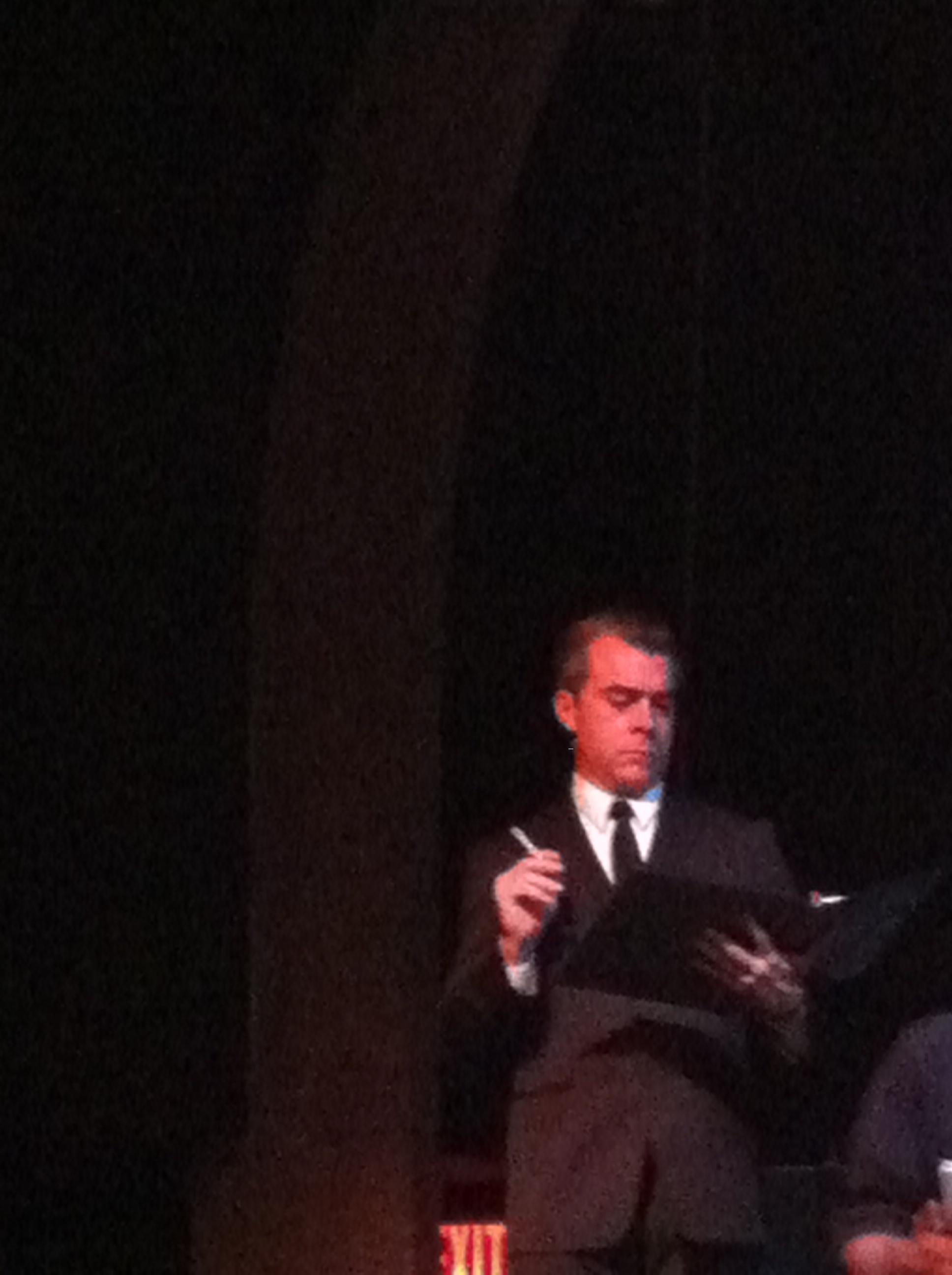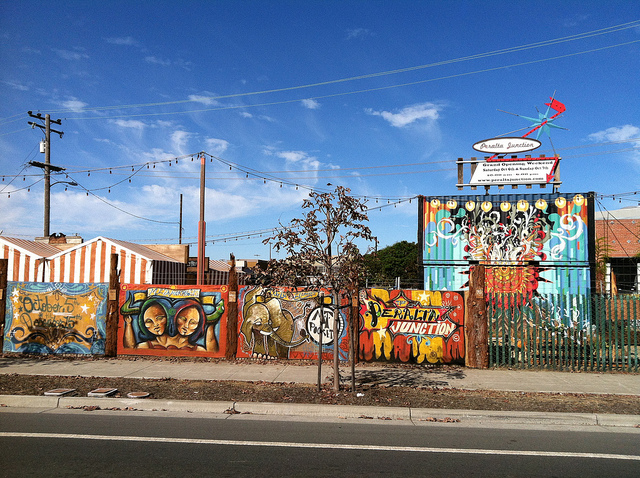I don’t know about you, San Francisco, but after the orange-and-black, champagne-and-candy-corn geyser that the past week has been, I’m ready for a little sobriety, a little quiet reflection, and a lot of community-crafted art (that vagina costume I saw walking down South Van Ness the other day notwithstanding.)
Thank goodness, the next few days are full of lovely Dia de los Muertos moments, and collections of altars honoring those who have passed continue to pop up in more and more places. I’ll even give up on harping on facepainted gringos for a moment. The Bay’s way may not be exactly how the holiday is celebrated in Mexico — but we have created a unique tradition of our own.
“Fluorescent Virgins”
“I realized we don’t talk about death, don’t bring the subject to surface even though we are extremely vulnerable to it,” SF State student Pilar Gordillo told me when I asked her why she was organizing a Dia de los Muertos altar exhibition. The resulting assemblage of shrines by six artists pays homage to passed loved ones, but with a distinctly contemporary patina, bringing the Day of the Dead celebrations all the way out to the Park Merced campus.
Through Nov. 8. Opening reception: Thu/1 5-8pm, free. SF State Cesar Chavez Student Art Center, 1650 Holloway, SF. Facebook: Fluorescent Virgins
Supper of the Souls
Raise money for the Mission Cultural Center for Latino Arts at a three-course meal in this neo-taqueria. On the menu are chicken with mole colorado, tamales, empanadas, arroz con leche, pan de muertos, and walls bearing art by the man who made La Catarina who she is today, turn-of-the-20th-century Mexican cartoonist Jose Guadalupe Posada.
Thu/1 6-9:30pm, $75. Tacolicious, 741 Valencia, SF. www.tacolicioussf.com
SOMArts’ altar installation
We love father-son team Rio and Rene Yañez, and the artistic duo’s curatorial powers shine at the yearly SOMArts altar exhibition. The cavernous main gallery of the arts center is turned into an atmospheric labyrinth of multimedia tributes to the dead, with some altars large enough to enter, sit down, and meditate on the fleeting nature of life.
Through Nov. 10. SOMArts Cultural Center, 934 Brannan, SF. (415) 863-1414, www.somarts.org
Los Lupeños de San José
The dancers may not be spinning in full white-and-black face, but this edition of City Hall’s free dance series will teach you more about authentic Mexican culture than many of the other events on this list. This Latino troupe has been twirling its skirts since 1969, benefiting from cheorography and mentorship from dance teachers both here and south of the border.
Fri/2 noon, free. SF City Hall rotunda, 1 Dr. Carlton Goodlett Pl., SF. www.dancersgroup.org
North Berkeley Day of the Dead
Bay Area Day of the Dead: not just for the Mission anymore. This year, you can play La Catrina in the burgeoning restaurant district of North Berkeley — or, if you’re not just looking for an excuse to wear facepaint, view altars and mourn those who have recently passed with a candle and your community in the somber night-time processional.
Fri/2 community altars: 5-7:30pm; candle-lit procession 7:45-9pm, free. Shattuck and Rose, Berk. www.gourmetghetto.org
“Death on Installment/La Muerte En Plan de Pagos”
We love the Mission Cultural Center’s ability to push dialogue forward when it comes to Latino art, and this year’s Day of the Dead exhibition curated by Maurizzio Hector Pineda promises to continue its tradition of excellence deeply rooted in community. Wander the colorful displays, check out Aztec dancers, maybe even make a mask while the Mission roils around you in Muerto fesitivities.
Through Nov. 17. Gala reception: Fri/2 6:30-10pm, $5. Mision Cultural Center for Latino Arts, 2868 Mission, SF. www.missioncultural.org
Pre-procession sugar skull workshop
Galeria de la Raza was the original center of the Mission’s Dia de los Muertos celebrations, so it only makes sense that you would come here before this year’s procession begins to celebrate with the neighbors. The gallery has been holding workshops teaching the finer points of refined sugar artistry all through October — whip up a sugar skull of your own real quick on this day of Catarina and candle.
Fri/2 6pm, free. Galeria de la Raza, 2857 24th St., SF. www.galeriadelaraza.org
Mission District parade and altars
There’s no denying that the community-led, candle-lit procession and park full of homemade altars can be breathtakingly lovely. Arrive early at Garfield Park to tiptoe around meticulously, sometimes even extravagantly decorated tributes to dead family members and public figures. Add a note of your own to the interactive exhibits, and await the arrival of the costumed procession, whose inevitable approximations of La Catrina are a distinctly San Franciscan way of celebrating the holiday. The all-ages percussion group Loco Bloco will be massing up at 5:30pm in front of Brava Theater (2781 24th St., SF) if you’re looking for the hot spot for skeleton beats, and to get your face painted.
Fri/2 Procession: 6-7pm, free. Starts at Bryant and 22nd St., SF; festival of altars: 6-11pm, free. Garfield Park, Harrison and 26th St., SF. www.dayofthedeadsf.org
SF Symphony Dia de los Muertos community concert
Is a skeleton a xylophone or a marimba? You can bet your sweet sugar skull there’ll be an ocean of chromatic bones, dancing akimbo, at the vibrant annual celebration of the afterlife. The family favorite boasts performances from the SF Symphony Youth Orchestra (playing Aaron Copland’s El Salón México and Jose Pablom Moncayo’s Huapango), dance company Los Lupeños de San José, Mariachi Nuevo Tecalitlán, and more, all narrated by the twinkling Luis Valdez, “father of Chicano theater.” Face painting, paper flower-making, tons of colorful art, and a pre-show by the Mixcoatl Anahuac Aztec dancers, the 30th Street Chorus, and the Solera singers boost the fun — but really they had us at cinnamon-infused Mexican hot chocolate and pan de muerto. (Marke B.)
Sat/3 2pm, $17.50–$68. Davies Symphony Hall, 401 Van Ness, SF. (415) 864-1000, www.sfsymphony.org











